Biology The Study of Life: Part 24 (Reconstructing Evolution Through Phylogenetic Systematics)
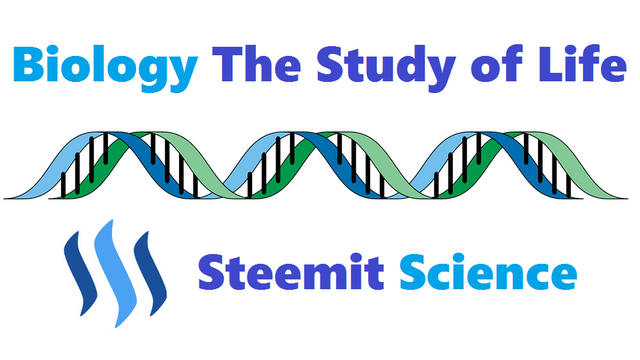
Introduction
This informative series of posts will explore modern biology; the fundamental principles of how living systems work. This material will always be presented at the level of a first-year college biology course, without assuming any prior background in biology or science. It also presents material in a conceptual format. Emphasizing the importance of broad, unifying principles, facts and details in the context of developing an overarching framework. Finally, the series takes a historical approach wherever possible. Explaining how key experiments and observations led to our current state of knowledge and introducing many of the people responsible for creating the modern science of biology.
Having addressed the question of how new species might arise, this post now turns to the question of how biologists organize the enormous diversity of living things.
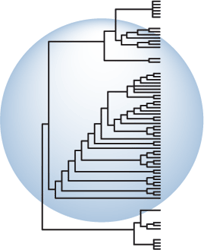
Older views on classification based on apparent similarities among groups of organisms suffer from the fact that these similarities may arise through convergent evolution. The post introduces phylogenetic systematics, a newer approach for reconstructing evolutionary history and relationships among a group of organisms based on statistical analysis, and shows the utility of this approach for understanding historical patterns of evolution.
Over the history of the Earth, the biological “information” in living things has diversified into millions of different species with complex and unique adaptations, each possessing DNA molecules with sequences of nucleotides that reflect those adaptations.
How can we sort out and make sense of this enormous diversity? More important, how can we determine the evolutionary history of a group of organisms, allowing us to better understand when and how particular traits arose? One reason to organize living things in a systematic fashion is that it provides insight into evolutionary patterns and processes. Another reason for understanding not only the systematic relationships among organisms but also the history that led to those relationships is that it is becoming increasingly clear that understanding evolutionary relationships provides insight into problems in medicine, agriculture, and conservation. In biology, the most relevant and useful way to classify living things is by their evolutionary history.
We have an intuitive feel for how to separate organisms into different groups, and this classification is the oldest activity we would consider biological science.
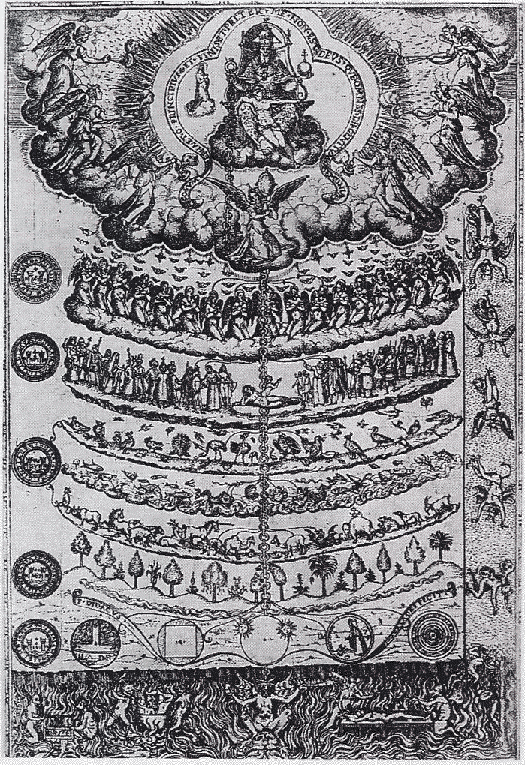
Aristotle went to great trouble to classify all living forms on his scala naturae, and taxonomy (the naming and classification of organisms by type) remained a dominant field in biology in Darwin’s time. The area of modern biology concerned with classification in an evolutionary context is called systematics.
Classifying, for example, two sparrows into separate species is an easy task. Even if given sparrows plus a duck and a vulture, we would easily group the sparrows together as being more similar to each other than to the duck and the vulture. However, we would incorporate the sparrows, duck, and vulture in a larger group if then shown a dog, a cat, and a lion, because the birds are more similar to each other than to the other animals. We probably would also group the cat and the lion together as being different from the dog among the mammals. If given a fruit fly, we would probably group all the other animals together in a group that excludes the fruit fly, because these animals are more similar to each other than to the fly.
There are two important characteristics of this intuitive classification scheme.
- It is based on shared similarities, such as skeletal features and body type.
- It is hierarchical, meaning that we have more and less inclusive groupings; for example, the cat and the lion are grouped together compared to the dog, but the dog, cat, and lion are all grouped together compared to the birds.
We usually classify organisms hierarchically, with the lowest levels containing very similar organisms and the higher levels containing progressively less similar organisms that are still more similar to each other than they are to other groups.
Carolus Linnaeus (Carl von Linne), an 18th-century Swedish botanist, formalized a hierarchical classification system that works much the same as the approach we just took and is still used by biologists today.
- Linnaeus’s system starts with species and groups similar species into genera (singular genus), similar genera into families, similar families into orders, and so forth up to classes, phyla, and kingdoms.
- In the Linnaean system, each organism received a series of names that not only identifies it but places it in the hierarchy of nested groups.
Linnaean taxonomy works well for classifying organisms in most cases (although there are many notable exceptions), but it does not tell us anything about the evolutionary histories and relationships of groups of organisms. The evolutionary history of a group of species is called its phylogeny.
Classical approaches to taxonomy and systematics assumed similarities between species reflected evolutionary relationships between them. However, this is not necessarily the case.
First, not all similarities are the result of descent from the same ancestor; rather, they may reflect a common set of selective pressures on unrelated species. This is known as convergent evolution. For example, dolphin flippers and fish fins are similar but evolved from completely different original structures. Structures that are similar because of convergent evolution are called analogous structures. Structures or features that are similar because of common ancestry are called homologous structures. Determining which structures are homologous and which are merely analogous can be quite difficult.
Second, even homologous structures do not always help us to determine evolutionary relationships. Cats, lions, and dogs share many characteristics that are not useful because they are all shared identically among these organisms. Only homologous structures that are shared by some but not all species in a group provide useful information.
Phylogenetic systematics was introduced in the 1960s by German entomologist Willi Hennig.
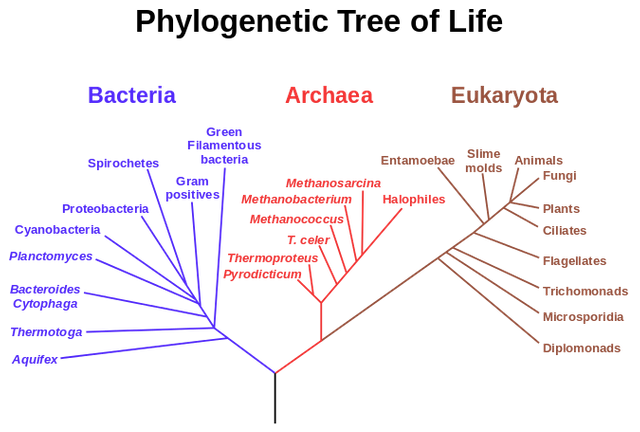
He realized that the evolutionary history of a group of organisms would be reflected in changes to the observable structures or features of those organisms. In this approach, structures or other features we are examining are referred to as characters, which can have different states. Hennig’s work used morphological (shape-based) characters, but modern characters are often DNA sequences. Hennig argued that some characters will change in some species but not in others, and that the differences would yield information about those species’ relationships. Each species represents a mix of primitive characters held in common with ancestor species and derived characters that differ from the ancestor species. Note, however, that organisms themselves are not “primitive” or “derived.” Hennig realized that the characters useful for determining evolutionary relationships among organisms would be those derived characters that are shared to differing degrees among species. These are called shared derived characters.
A simple example illustrates how shared derived characters can be used to generate a phylogeny.
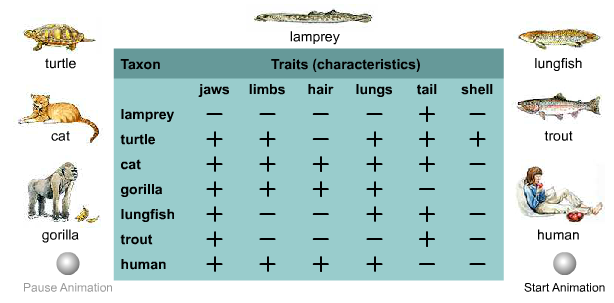
Modern systematists, however, use computers and vast amounts of data to generate probabilities of the degree to which species are related to each other.
- Seven species (a lamprey, a trout, a lungfish, a turtle, a cat, a gorilla, and a human) share six characters (jaws, limbs, hair, lungs, tail, and shell) to varying degrees.
- We can generate a matrix that shows how species do or do not share characters.
- An important assumption is that the characters used are homologous, which of course, is not always easy to determine.
- We also must choose a species that we assume to be the most primitive, which is called the outgroup (in this case, the lamprey).
- The character states of the outgroup then are defined as the primitive states of those characters, and any deviation is considered a derived state. For example, because lampreys have no hair, the presence of hair is the derived state for that character.
- By comparing patterns of shared derived traits, we can identify species that are evolutionarily closer to each other. For example, gorillas and humans share 5 derived traits, while cats and humans share 4. We conclude that humans are closer to gorillas than to cats—that is, they share a more recent common ancestor.
Performing this type of analysis with many characters and for many organisms generates a branching tree.
Each species occupies the tip of a branch and is joined to other species at forks (or “nodes”), which occur higher or lower on a branch, depending on how closely related the species are. The vertical dimension of the tree represents evolutionary time, and branching points at similar vertical levels imply relationships between species. This may seem obvious, but it also means that, for example, lungfish are more closely related to humans than to trout!
Phylogenetic systematics transformed taxonomy by providing a framework for deciding how species are related to each other. When using genetic characters, this framework enables us to look at the evolutionary histories of both populations and species and, thus, represents information at the highest level of biological hierarchy.
END PART 24
BIOLOGY THE STUDY OF LIFE:
PART 1 INTRODUCTION
PART 2 WHAT IS LIFE
PART 3 ORIGIN OF LIFE
PART 4 CELL TO ORGANISM
PART 5 PROTEINS
PART 6 CODE OF LIFE
PART 7 DOUBLE HELIX
PART 8 REPLICATING DNA
PART 9 CENTRAL DOGMA
PART 10 GENETIC CODE
PART 11 DNA TO RNA
PART 12 RNA TO PROTEINS
PART 13 MISTAKES HAPPEN
PART 14 WHEN CELLS DIVIDE
PART 15 MENDEL'S PEA PLANTS
PART 16 SEX AND VARIATION
PART 17 GENES AND CHROMOSOMES
PART 18 CHARLES DARWIN ON THE ORIGIN OF SPECIES
PART 19 NATURAL SELECTION
PART 20 DARWIN VS MENDEL
PART 21 MECHANICS OF EVOLUTIONARY CHANGE
PART 22 WHAT ARE SPECIES AND HOW DO NEW ONES ARISE
PART 23 ORIGINS OF NEW SPECIES
PART 24 RECONSTRUCTING EVOLUTION THROUGH PHYLOGENTIC SYSTEMATICS
Image Credits -
http://evolution.berkeley.edu/evolibrary/images/phylogenetics/genericclade.gif
https://upload.wikimedia.org/wikipedia/commons/b/b5/Great_Chain_of_Being_2.png
https://upload.wikimedia.org/wikipedia/commons/thumb/7/70/Phylogenetic_tree.svg/675px-Phylogenetic_tree.svg.png
http://www.cengage.com/biology/discipline_content/animations/cladogram_construction.html
Bird [Giphy](https://giphy.com/gifs/blue-5lDik5jPpRw2Y)
typic

 or
or  @pjheinz
@pjheinz

You said 'typic'
Ahhhhhhhhhhh!
You said 'typic'
Ahhhhhhhhhhh!
You said 'typic'
Ahhhhhhhhhhh!
You said 'typic'
Ahhhhhhhhhhh!
You said 'typic'
Ahhhhhhhhhhh!
You said 'typic'
Ahhhhhhhhhhh!
You said 'typic'
Ahhhhhhhhhhh!
You said 'typic'
Ahhhhhhhhhhh!
You said 'typic'
Ahhhhhhhhhhh!
You said 'typic'
Ahhhhhhhhhhh!